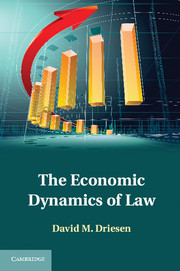
Reposted from RegBlog.
Traditionally, the field of law and economics has treated government regulation as if it were a mere transaction. This microeconomic approach to law assumes that government regulators should aim to make their decisions efficient by seeking to equate costs and benefits at the margin.
As I argue in a new book, The Economic Dynamics of Law, the microeconomic model of government regulation misconceives the essence of regulation. Government regulation produces not an instantaneous transaction, but a set of rules intended to influence future conduct, often for many years. Accordingly, regulation provides a framework for private resource allocation, rather than allocating the resources itself. This framework performs a macroeconomic role by reducing systemic risks that might permanently impair important economic, social, and natural systems. As such, government regulation resembles monetary policy, which likewise affects, but does not control, resource allocation. 
Properly understood, the relationship between law and the economy implies that private actors can ameliorate the effects of nominally inefficient government decisions. Capitalism works precisely because government cannot assimilate sufficient information to make perfectly efficient decisions. Yet, the neoclassical model of law and economics assigns government the efficiency-enhancing role that properly belongs to private actors.
In The Economic Dynamics of Law I propose a more appropriate way of thinking about regulation. This approach focuses on the shape of change over time in order to avoid systemic risk. We cannot expect government to make perfectly efficient decisions or ensure our future happiness, but we should, at a bare minimum, expect government to ward off catastrophes, leaving much of the fine-tuning to private markets.
I also propose a form of institutional economic analysis that I call economic dynamic analysis, as a way to aid regulators in analyzing threats and responding efficaciously. Economic dynamic analysis requires regulators to study how relevant actors respond to economic incentives, taking into account the level of bounded rationality anticipated in each group of regulated actors. Such analysis requires, in particular, consideration of countervailing incentives that may defeat legal incentives. Economic dynamic analysis also calls for the use of scenario analysis in the case of some of our most serious problems. Finally, it includes empowerment analysis to determine who law might empower or disempower, as an extension of public choice theory.
Although economic dynamic analysis may appear novel, perceptive analysts already implicitly employ this form of analysis, or at least many of its elements. Its practitioners have included scholars such as Ian Ayres, Yochai Benkler, and Garrett Hardin.
Economic dynamic analysis is an important tool for detecting systemic risk and preventing regulatory failure. By contrast, neoclassical law and economics helped support the deregulation of financial markets that precipitated the financial crisis. If one assumes that market actors are rational and act on perfect information, as the neoclassical model does, then it follows that we have little need for government regulation. The neoclassical worldview played a critical role in producing the regulatory reforms that made possible the offering and securitization of subprime adjustable-rate mortgages and the creation of too-big-to fail institutions, which could not be formed in the era of the Glass-Steagall Act, restrictions on interstate banking, and vigorous antitrust enforcement.
Greater reliance on economic dynamic analysis could have forestalled the financial disaster of 2008. Nouriel Roubini, Dean Baker, Arthur E. Wilmarth, Jr., and Lynn Stout all foresaw the coming economic crisis made possible by deregulation. None of them relied on cost-benefit analysis or sophisticated mathematical models of any kind. Instead, they studied the economic dynamics of the housing market or the incentives that deregulation had created. This does not prove that economic dynamic analysis always provides a basis for prophecy, but it does make early detection of systemic risk more likely than available alternatives.
Importantly, when government regulators had to address the possibility of a market collapse as large financial institutions began to fail in 2008, they conducted no cost-benefit analysis in deciding how to act. How could they? The benefit of bailing out a bank, for example, would have equaled the difference between the losses incurred without the bailout and those incurred with a bailout. Neither was a calculable number.
Instead, regulators at that time conducted an economic dynamic analysis. They recognized that the economy faced a danger of collapse because the failure of major financial institutions could produce a domino effect as irrational fear took over and decimated the economy. In other words, they implicitly analyzed how investors, within the known bounds of their rationality, would react to such failures in order to understand the economic dynamics involved. Accordingly, governments took action -- bank bailouts in some countries, nationalization in others -- calculated to counteract these negative dynamics. Their action helped us avoid an immediate and complete economic collapse. In doing so, policymakers not only implicitly performed economic dynamic analysis; they countered a negative trend in order to avoid systemic risk.
The goal of avoiding systemic risk while keeping open a reasonably robust set of economic opportunities informs other areas of regulation as well. The United Nations Framework Convention on Climate Change, for example, has a stated goal of avoiding dangerous climate change—in other words, of avoiding systemic risk. The European Union has taken that goal seriously and made progress in reducing greenhouse gas emissions. By contrast, the United States has tended to heed the counsel of some economists conducting cost-benefit analysis and has done very little about climate disruption, thereby risking a serious catastrophe.
The economic crisis and the failure to adequately address climate disruption show that neoclassical law and economics has failed us. Yet legal scholars have not devised a broadly applicable framework to replace it. The Economic Dynamics of Law provides such a framework and shows that it applies much more broadly than one might suspect.
David Driesen, CPR Member Scholar; University Professor, Syracuse University College of Law, Syracuse University . Bio.
| Be the first to comment on this entry. |